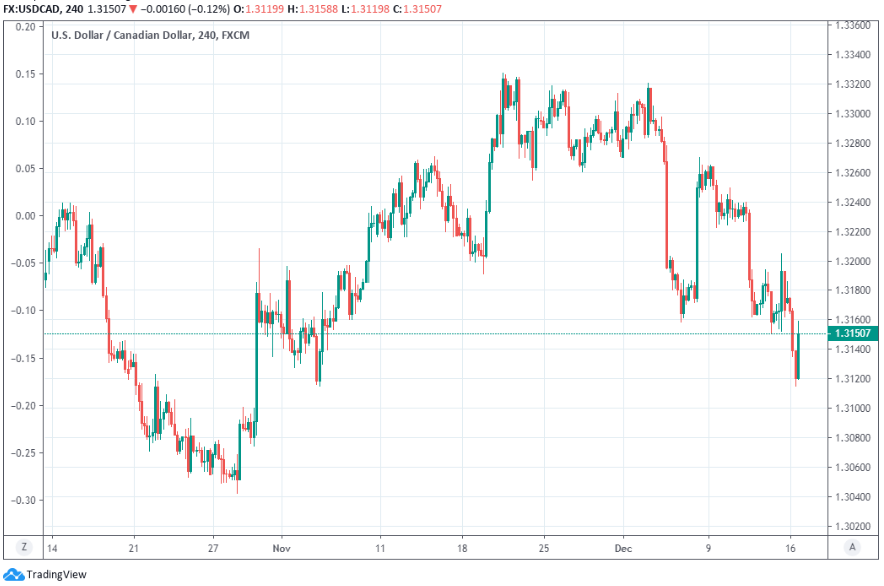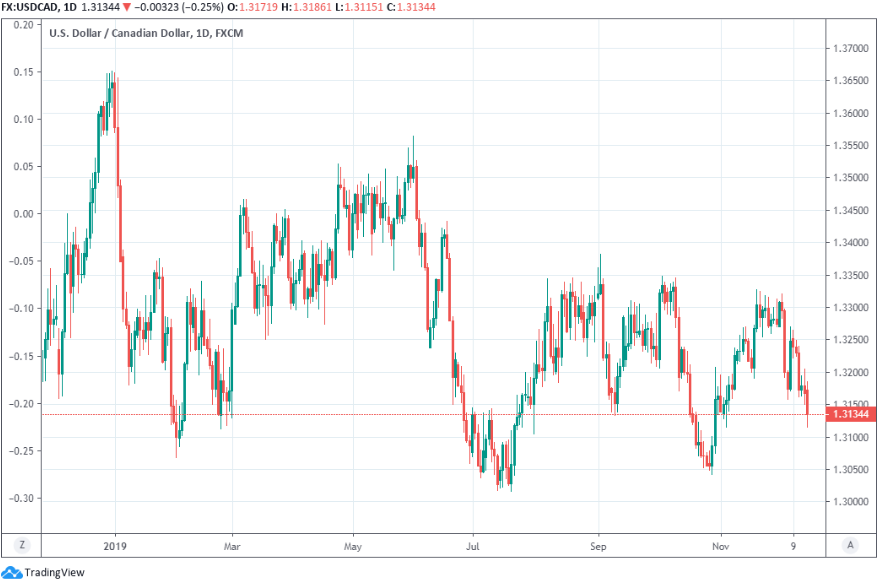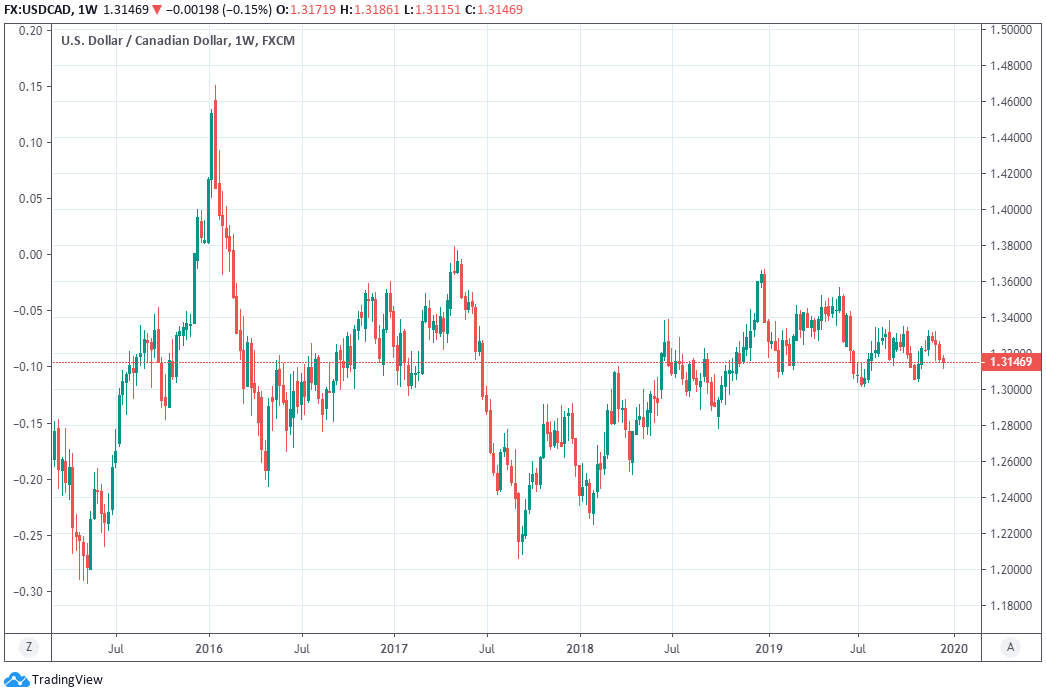Canadian Dollar Tipped for Gains into Year-end on Boost to Risk Assets
- Written by: James Skinner
-

Image © Adobe Stock
- CAD on front foot in risk-on market at open of new week.
- As U.S.-China deal, UK election and USMCA aid risk assets.
- Scotiabank sees USD/CAD fall into year-end on risk appetite.
- SEB looks for USD/CAD return to Trump era lows next year.
- But Saxo Bank sees USD/CAD struggling to break 1.30 level.
The Canadian Dollar was on its front foot Monday as a hat-trick of positive developments on the international trade front continued to lift market risk appetite, although some analysts are tipping further gains into year-end.
Canada's Dollar got the better of all major rivals except the Swedish Krona and Norwegian Krone Monday as investors chased so-called risk assets higher including the Loonie, which lagged other currencies in a global pushback against the U.S. Dollar late last week after President Donald Trump announced a “very large phase one deal” to end the trade war with China.
President Trump's declaration of a deal came hard on the heels of a landslide win for Prime Minister Boris Johnson in the UK general election and amid chatter suggesting the USMCA replacement of the North American Free Trade Agreement (NAFTA) could be successfully run the Washington gauntlet this week, all of which have helped at least partially dispel fears in the market over a possible crunch in the global economy.
Trump's deal, which has not yet been made public and may not be signed until the end of January, has already averted one volley of tariffs that were supposed to land on China's remaining untariffed exports to the U.S. on Sunday and is expected to lead to a reduction of existing tariffs on both sides. Meanwhile, the UK election outcome has buried the threat of a 'no deal' Brexit at least until the end of 2020 while progress on USMCA will neuter the most direct trade-related threat to Canada's economy.

Above: USD/CAD rate shown at 4-hour intervals.
"Today’s dollar-weakness appears to follow the relatively muted market reaction late last week to trade news (USMCA and China-US) and the Tories’ victory in Thursday’s election in the UK. On the surface, the combination of these three would have pointed to a weaker USD through last week. Yet, there remain risks in each of these matters that may have limited USD weakness," says Shaun Osborne, chief FX strategist at Scotiabank. "The JPY and CHF are underperforming within the G-10 space owing to the risk-on tone in markets, which has provided a boost to the AUD, NZD, and CAD, while the MXN is unchanged owing to USMCA uncertainty."
Last week's hat-trick of geopolitical headlines has quelled fears about another damaging blow being dealt to the global economy by more U.S. tariffs while the prospect of some existing tariffs being rolled back has gotten markets hoping the pact might prompt a small global economic rebound in the months ahead.
That deflated the U.S. Dollar, Japanese Yen and Swiss Franc while lifting so-called risk currencies like the Australian, Canadian and New Zealand Dollars as investors bet on brighter days ahead for the global economy, which has been wounded by the 18-month long tariff fight between the U.S. and China.
Recovering risk appetite could weigh on the USD/CAD rate into year-end, Scotiabank's Osborne says, while analysts at Nordic lender SEB said Monday that they're looking for the exchange rate to continue falling once into 2020.

Above: USD/CAD rate shown at daily intervals.
"The CAD will continue to outperform the USD in 2020. Part of the story is expectations of a generally weaker USD, which usually feed into a move lower in USD/CAD as well, but this is far from the only reason. The Canadian economy is doing well with inflation close to the target, unemployment rate near historical lows and accelerating wage growth," says Richard Falkenhall, a senior currency strategist at SEB. "The CAD is also positively correlated with improved risk appetite and in a main scenario where the global manufacturing sector recovers in 2020, this will be an advantage against the USD."
SEB says the gap between U.S. and Canadian interest rates combined with the current level of oil prices suggests the USD/CAD rate should be trading closer to 1.22 however, the bank forecasts the exchange rate will fall only as far as 1.25 next year because the Bank of Canada (BoC) is expected to cut interest rates which will have an adverse impact on the value of the Canadian currency.
Scotiabank forecasts a USD/CAD rate decline to 1.30 by the end of 2019, followed by a steady fall to 1.25 next year. And as far as the very short-term outlook goes, the bank's technical analysts say that losses could accelerate in the coming days, taking the exchange rate down to its late October low around 1.3042. However, and as much as there are plenty of voices out there calling for a higher Canadian Dollar, some see the Loonie nearing the end of its road.
"The loonie is standing out on the strong side as the USMCA trade deal nearing passage looks to see Canada avoiding any further negative trade focus. But to get USDCAD down through 1.3000 we need a weaker USD and CAD won’t be a performer on any weaker US economic performance," says John Hardy, chief FX strategist at Saxo Bank.

Above: USD/CAD rate shown at weekly intervals.
Time to move your money? The Global Reach Best Exchange Rate Guarantee offers you competitive rates and maximises your currency transfer. Global Reach can offer great rates, tailored transfers, and market insight to help you choose the best times for you to trade. Speaking to a currency specialist helps you to capitalise on positive market shifts and make the most of your money. Find out more here.
* Advertisement










